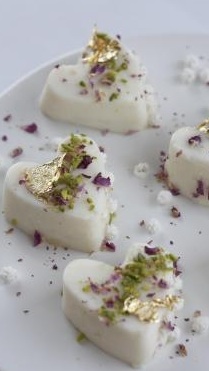به زبان فارسی
PICTORY
LATEST MUSIC
SEARCH
The Persian Rose
by Ariana Bundy
20-Jul-2012
Ever since I was a child, I've been comparing any rose I saw to the ones from Iran. I would climb fences, cross roads, come to a screeching halt just to get out of my car and smell a rose sticking out from someone's garden or growing wild on the road side, thinking to myself, maybe this one will smell like the one at home? I would even gage the air and whether it had just rained or possibly if the flower was under enough sun to have released some aroma. My grandmother's roses were spectacular. My mother would cut them and place them in vases all over the house: pink with red edges, sunny yellow, deep crimson red, orange turning into coral at the ends or pure crisp white. They would last for at least 10 days, opening up slowly, each day revealing a bit more beauty until they reached the height of their magnificence and then slowly go limp, their velvety petals falling gracefully on the tables. If you have been to Iran and smelled a Persian rose, you will know exactly what I mean. But then again you could just simply open a bottle of Persian rose water.....
Excerpt from my latest book: Pomegranates and Roses: my Persian family recipes(Siumon & Schuster UK)
The rose has been cultivated in Persia's province of Faristan since 810 BC. It was the world's center of production of rosewater, exporting all over the world, including China. They were also required to give 30,000 bottles of rosewater a year to the Caliph in Baghdad. In fact, it is said that the Damsk rose (Gol-e-Moahammadi) a delicate bright pink flower, is Iranian in origin and not as the name suggests Syrian.
Iranians have a special relationship with the Rose. It is not only a part of Persian motifs in art but also often referenced in poetry where it is depicted as beautiful perfection and object of longing adoration and admiration of the nightingale, who represents the poet or the lover forever singing longingly about his devotion to her. This relationship had been ongoing for one thousand years! Omar Khayam the 11th century Persian poet and philosopher who wrote the famous Rubaiyyat, was a passionate lover of the rose (as well of wine). He had told one of his pupils that his tomb will be in a spot where the North wind may scatter roses over it. A rose tree was planted on his grave at Naishabur in Shiraz. In fact, a clipping from this tree was later brought and was planted at the grave of Edward Fizgerald in Suffolk, England.
The rose's petals, oil and essence is not only used as a perfume, but also in food, and for medicinal and religious purposes.
Although they grow in various places in Iran such as Shiraz, Kerman, Kashan and Golpayehgaan, the most beautiful smelling ones come from Kashan located in the middle of the arid desert where roses are irrigated using ancient elaborate systems of underground aqueducts fed with natural spring water. No pesticides are used, making them naturally organic.
The rose festival or the Golabgiran ceremony of Qamsar in the Kashan region of Iran is a beautiful sight to behold. Women in colourful traditional clothes pick the roses by hand, just before sunrise. They peel off the petals and put them in large copper pots over burning wood embers to simmer in with natural spring water. Tons of rose petals is needed to produce rose water and even more to obtain its essential oil. This traditional method of obtaining the oil and essence also helps in keeping the aroma intact.
In some nearby villages, people make an extract out of the remaining rose hip and spread it on toast for breakfast! Also, roses are the preferred flowers for gracing people's homes.
To order book: //www.amazon.co.uk/Pomegranates-Roses-Persian...
Facebook page : https://www.facebook.com/pages/Ariana-Bundy/937355...
| Recently by Ariana Bundy | Comments | Date |
|---|---|---|
| Ghaliyeh Mahi | - | Aug 16, 2012 |
| Our beloved Rice | 4 | Jul 09, 2012 |
| Interview on Dubai TV, talking about new cookbook 'Pomegranates & Roses: my Persian family recipes' | - | Jul 03, 2012 |
RECENT COMMENTS
IRANIANS OF THE DAY
| Person | About | Day |
|---|---|---|
| نسرین ستوده: زندانی روز | Dec 04 | |
| Saeed Malekpour: Prisoner of the day | Lawyer says death sentence suspended | Dec 03 |
| Majid Tavakoli: Prisoner of the day | Iterview with mother | Dec 02 |
| احسان نراقی: جامعه شناس و نویسنده ۱۳۰۵-۱۳۹۱ | Dec 02 | |
| Nasrin Sotoudeh: Prisoner of the day | 46 days on hunger strike | Dec 01 |
| Nasrin Sotoudeh: Graffiti | In Barcelona | Nov 30 |
| گوهر عشقی: مادر ستار بهشتی | Nov 30 | |
| Abdollah Momeni: Prisoner of the day | Activist denied leave and family visits for 1.5 years | Nov 30 |
| محمد کلالی: یکی از حمله کنندگان به سفارت ایران در برلین | Nov 29 | |
| Habibollah Golparipour: Prisoner of the day | Kurdish Activist on Death Row | Nov 28 |



